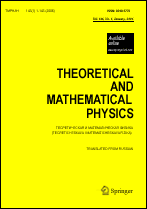|
Integration of the two-dimensional Heisenberg model by methods of differential geometry
A. B. Borisov
Institute of Metal Physics, Ural Division of the Russian Academy of Sciences, Ekaterinburg, Russia
Abstract:
The methods of classical differential geometry are used to integrate the two-dimensional Heisenberg model. After the hodograph transformation, the model equations are written in terms of the metric tensor associated with a curvilinear coordinate system and its derivatives. It is shown that their general solution describes all previously known exact solutions except a flat vortex. A new type of vortex structure, a “vortex strip”, is predicted and analyzed in two-dimensional ferromagnets. Its typical properties are the finite dimensions of the domain of definition, the finiteness of the total energy, and the absence of a vortex core in the presence of a vortex structure.
Keywords:
Heisenberg model, differential geometry, metric tensor, general solution, vortices, isotropic magnet, vortex street, exact solutions.
Received: 14.02.2023
Revised: 13.03.2023
Citation:
A. B. Borisov, “Integration of the two-dimensional Heisenberg model by methods of differential geometry”, TMF, 216:2 (2023), 302–314; Theoret. and Math. Phys., 216:2 (2023), 1168–1179
Linking options:
https://www.mathnet.ru/eng/tmf10481https://doi.org/10.4213/tmf10481 https://www.mathnet.ru/eng/tmf/v216/i2/p302
|


| Statistics & downloads: |
| Abstract page: | 154 | | Full-text PDF : | 6 | | Russian version HTML: | 57 | | References: | 30 | | First page: | 9 |
|




 Contact us:
Contact us: Terms of Use
Terms of Use
 Registration to the website
Registration to the website Logotypes
Logotypes








 Citation in format
Citation in format 